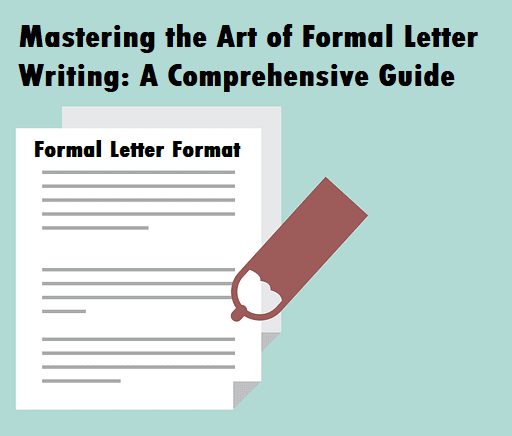Formal letters are an integral part of professional communication. Whether you’re writing a job application, a business proposal, or a complaint letter, following the correct formal letter format is essential to convey your message effectively.

Formal Letter Format
While communicating in professional way through letters, the letters should be written in proper format which will make your communication strong. Let’s a comprehensive guide to mastering the art of formal letter writing, including the structure, salutations, body paragraphs, and closing of a formal letter.
1. Letterhead and Contact Information
Every formal letter should begin with your contact information, including your full name, address, phone number, and email address. Place this information at the top of the letter, aligned to the right or left margin. If you are representing an organization, include the official letterhead with the organization’s name, logo, and address.
2. Date
Below your contact information, leave a space and write the date. Use a standard date format, such as “May 21, 2023.” Ensure that the date is aligned with the left margin.
3. Recipient’s Contact Information in formal letter
Leave another space after the date and write the recipient’s contact information, including their full name, job title, organization name, and address. Address the recipient directly and use a formal salutation such as “Dear Mr./Ms./Dr. [Last Name].”
4. Salutation in formal letter
The salutation is an important aspect of formal letters as it sets the tone for the entire communication. Use the appropriate salutation based on your familiarity with the recipient. Examples include:
- “Dear Mr. Rajesh,” (formal, when addressing a male)
- “Dear Ms. Ragini,” (formal, when addressing a female)
- “Dear Dr. Srivastava,” (formal, when addressing someone with a doctorate)
- “Dear Sir/Madam,” (formal, when the recipient’s gender is unknown)
5. Opening Paragraph
The opening paragraph should concisely state the purpose of your letter and provide a brief introduction. Clearly and directly communicate the reason for writing, whether it’s an inquiry, a request, a complaint, or any other matter. For example, if you’re writing a job application, mention the specific position you are applying for and how you learned about the opportunity.
6. Body Paragraphs of formal letter
The body of the letter is where you provide detailed information, present arguments, or elaborate on the purpose of your communication. Organize your thoughts into separate paragraphs, each focusing on a specific point. Ensure clarity and coherence by using logical transitions between paragraphs.
Support your statements with relevant facts, examples, or evidence. Be concise and specific, avoiding unnecessary details. Use a professional and courteous tone throughout the body of the letter, maintaining a formal style.
7. Closing Paragraph in formal letter
The closing paragraph summarizes the main points of your letter and may include any necessary follow-up actions or requests. Restate your purpose if needed and express your expectations or desired outcomes. If appropriate, offer assistance or propose a solution. End the paragraph with a polite closing statement.
8. Complimentary Close in formal letter
Choose a complimentary close that matches the formality of your letter. Common examples include:
- “Yours sincerely,” (formal, when addressing a specific person by name)
- “Yours faithfully,” (formal, when the recipient’s name is unknown)
- “Best regards,” (semi-formal)
- “Sincerely,” (semi-formal)
Place the complimentary close on a new line, aligned with the left margin.
9. Signature in formal letter
Leave a few blank lines below the complimentary close to provide space for your signature. Sign your name in ink between the complimentary close and your typed full name. If you are sending a printed or emailed letter, you can use a scanned image of your signature.
10. Typed Name and Designation in formal letter
Below your signature, type your full name and your professional designation, if applicable. This ensures clarity and provides additional contact information.
11. Enclosures and Attachments in formal letter
If you are including any additional documents, such as a resume or supporting materials, mention them in the letter by writing “Enclosure” or “Attachment” below your typed name. If there are multiple documents, indicate the number, e.g., “Enclosures: 2” or “Attachments: 3.”
12. Proofreading and Editing
Before sending your formal letter, take the time to proofread it for spelling, grammar, and punctuation errors. Ensure that the content is clear, concise, and effectively conveys your message. Make any necessary revisions or edits to improve the overall quality and professionalism of your letter.
Conclusion
Mastering the art of formal letter writing is essential for effective professional communication. By following the correct format, including the letterhead, date, recipient’s contact information, salutation, body paragraphs, closing, and signature, you can create impactful and well-structured formal letters. Remember to maintain a professional tone, be concise, and proofread your letter before sending it. With practice, you will become proficient in crafting effective formal letters for various business and professional purposes.
